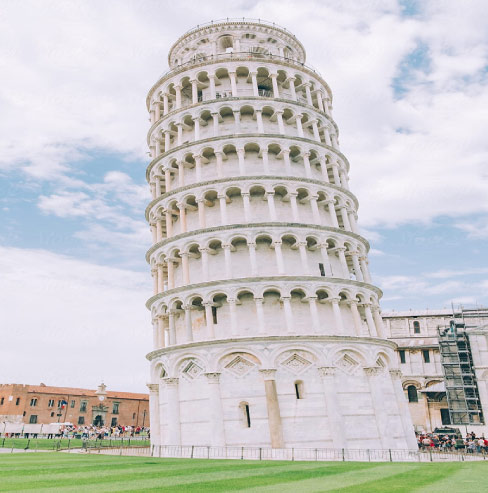“Will My Stone Be OK Outside?”
A Lesson in the Durability of Stone
Sharon Koehler
Artistic Stone Design
 |
|
Almost everyone has heard of the Leaning Tower, but few understand its significance to building with natural stone. |
We show up to work every day in our cars and trucks. We sell, fabricate or install some sort of stone or quartz with our drills, CNCs, bridge saws, suction lifting systems, carts, and all the other tools we use to make the job easier. We have laser templates, Fastbacks and robots to measure and cut. We can dye stone, etch and sandblast stone or leather stone. We have all the technologies known to man, so we can pretty much manipulate the stone to be almost anything we want. Almost.
The question is, “What about before technology?” The world has so many natural stone monuments created well before even the basics of modern technology were a glimmer on the horizon.
Think about the Leaning Tower of Pisa in Italy. Made almost entirely from marble, quartzite and limestone in a time when there was no modern tooling, CNCs or even electricity available. This stone wonder shows us that our ancestors were truly engineers, artists and craftsmen. Yes, it does lean, but that is a soil issue, not an engineering or construction faux pas. The tower weighs approximately 14,500 TONS (approximately the same weight as about 828 Navy battleships or 2,400 elephants) The soil at the site of the tower is very soft, and the weight of the tower compressed it and created the lean. It actually started to lean before it was completed.
Construction started in 1173 but was halted twice by war. One time construction was halted for 100 years. The general theory is that if they had finished it all at one time the tower would have collapsed because the engineers would not have identified the lean until it was too late. Due to the construction delays the engineers had the opportunity to make adjustments to the tower design, constructing it in almost a banana shape to offset the lean. In 1990 the lean was identified as 5.5 degrees (almost 15 feet off center). The tower was then closed for just over 10 years to “straighten” it a bit. They succeeded in getting it back to a 4 degree lean. They also declared it stable for the next 300 years.
The tower is 8 stories tall with a bell tower containing 7 bells. The circular tower stands between 186- and 187-1/4 feet tall. (Depending on which side you measure!) It is made up almost entirely of beautiful white marble. Some local marble was used, but the majority of the marble came from other countries such as Turkey, Greece and Africa. Quartzite and limestone were also used in the construction as well. Limestone was used in the non-visible portions of the tower.
Oddly enough, the choice of limestone for the inner structure is thought to be another reason that the tower has not collapsed, because the limestone is thought to be more flexible than the marble. Had it been 100 percent marble, the conjecture is that it would have collapsed a long time ago.
This marble tower also contains 207 columns, two twin spiral staircases with approximately 294 to 296 steps each (again, depending on which side you are on). There are 15 marble arches on the first story, 30 arches each on the next 6 stories and 16 on the top bell tower portion.
Had the construction not been halted multiple times by war, it is thought it would have taken about 185 years to complete instead of the 344 years it actually took.
800 years later, hampered by soft soil and war and with a little help from modern man, the tower still stands. Is it a testament to the ancient architects, engineers, laborers, stone masons and carvers? Sure it is. People come from the world over to see it, study it or just take in its 800-year-old history.
It is also a monument that shows the mesmerizing beauty, flexibility and durability of natural stone. So, the next time a customer asks you if it’s OK to use natural stone for an outdoor kitchen or they want to know how durable natural stone is, just tell them the story of the Leaning Tower of Pisa. That should do it.
Please send your thoughts on this article to Sharon Koehler at Sharon@asdrva.rocks.